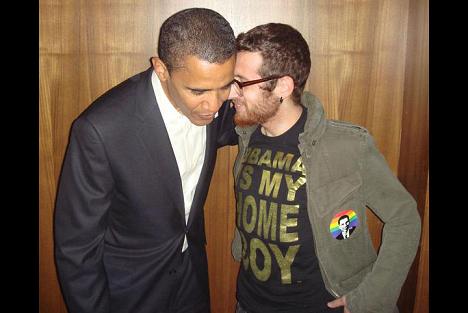At first glance, the National Endowment for the Arts (NEA) conference call of August 10th, 2009 sounds innocent enough because it’s supposedly been organized by Michael Skolnik, political director for Russell Simmons and someone not officially associated with any government agency. Skolnik appears to be acting independently as a concerned citizen and to have taken it upon himself to gather together a group of artists and art organizations hoping to move them towards “national service.” And how nice of the White House, the federal government and the NEA to make the time to participate in the call and aid this group of American artists motivated to help their country and community.
But this is only how things appear.
All evidence points to the fact that the conference call was a ruse, a front for a White House using Skolnik as a kind of beard in order to put an innocent spin on their abuse of the NEA and two non-partisan volunteer organizations (United We Serve – an initiative overseen by The Corporation for National and Community Service – a federal agency, and the White House’ Office of Public Engagement).
The goal: To motivate a group of hand-picked pro-Obama artists (grant recipients or those wanting grants) to push the President’s flagging agenda, especially health care — and to funnel this promotion through the ACORN related- Serve.gov website.
***
Documentation gathered by Big Hollywood’s Patrick Courrielche and the Washington Times, coupled with a newly revealed audio recording of the full conference call, points to eight troubling facts that put the full context of the call in a very disturbing light.
1. The NEA did not want it known they had any part in organizing the call. When the Washington Times asked Yosi Sergant, the NEA’s then-Director of Communications (he was “reassigned” on Sept. 10th after the story broke) about the call, he claimed the NEA was only a participant and that Skolnik had set up the call.
2. We know Sergant lied to the Washington Times. The NEA did send the email invite for the conference call. Worse, Sergant himself sent it, letting this group of artists and art organizations know the call would focus on “core areas of recovery,” starting with “health care.”
3. We know that United We Serve (with the ACORN-related Serve.gov website) claims they were merely a participant in a conference call arranged by someone they referred to as an “individual interested” in their group. It seems obvious they mean Michael Skolnik.
4. Michael Skolnik was not merely an “individual interested” in United We Serve, but in fact was asked by the White House and the NEA to round up artists on their behalf. We know this because in the newly revealed audio of the call, Skolnik says so.
5. The conference call audio makes clear that everyone addressing the artists and art organizations are fully aware they’re speaking to pro-Obama partisans; the same artists who helped the president win the 2008 election.
6. While addressing this group of Obama supporters, United We Serve, The Office of Public Engagement and the NEA repeatedly focus on four areas where “national service” is most needed … and health care always comes first.
7. We know that both Nell Abernathy of United We Serve and Buffy Wicks with The Office of Public Engagement heard and did not dispute Michael Skolnik’s opening statement asserting he had brought these artists together at the request of the White House and NEA, and that one of the goals of the call was to “push the president and push his administration.”
8. The remainder of this piece will prove a pattern shared by all three “guest” speakers: Sergant, Wicks and Abernathy:
- As mentioned above, all know this is a gathering of pro-Obama supporters.
- All make clear they want these pro-Obama artists and art organizations to funnel their activism through Serve.gov, which we now know filters activists to ACORN.
- When it comes to specific areas of activism, health care comes first.
***
THE PLAYERS:
Michael Skolnik – call moderator, political director for hip-hop mogul Russell Simmons.
Nell Abernathy – Director of Outreach for United We Serve, an initiative overseen by The Corporation for National and Community Service, a federal agency.
Buffy Wicks — The Office of Public Engagement (White House).
Yosi Sergant – Communications Director for the NEA, now “reassigned.”
***
THE CALL: [all emphasis added]
0:00 – 8:30: This time is eaten up with everyone involved getting settled into the call. Jokes are made about how many people are on from Los Angeles. This fact will be pertinent in establishing that Buffy Wicks and Nell Abernathy were on the call from the beginning.
Michael Skolnik — 8:40 – 12:50:
Skolnik’s opening statement sets the stage for the call; why the call was arranged and what the goals are.
Skolnik states openly that the White House and NEA asked him to round everyone up…
I have been asked by folks in the White House and folks in the NEA about a month ago in a conversation that was had. We had the idea that I would help bring together the independent artists community around the country.
Skolnik believes that only those who campaigned for President Obama are on the call:
[I]t’s clear as an independent art community as artists and thinkers and taste-makers and marketers and visionaries on this call, the role that we played during the campaign for the president and also during his first 200 some odd days of his presidency and the president has a clear arts agenda and has been very supportive of using art and supporting art in creative ways to talk about some of the issues that we face here in our country and also to engage people.
Skolnik lays out the goals for the call, ending with, “push the president and push his administration.”
And I think all of us who are on this phone call were selected for a reason, and you are the ones that lead by example in your communities. You are the thought leaders. …
And so I’m hoping that through this group and the goal of all this and the goal of this phone call, is through this group that we can create a stronger community amongst ourselves to get involved in things that we’re passionate about as we did during the campaign but continue to get involved in those things, to support some of the president’s initiatives, but also to do things that we are passionate about and to push the president and push his administration.
Skolnik then introduces Nell Abernathy with United We Serve – Serve.gov, who immediately hands the call over to Buffy Wicks with the White House Office of Public Engagement.
***
BUFFY WICKS – 13:00 – 21:42
Buffy Wicks also believes that the only people participating in the call are partisan artists and art organizations who helped elect Obama:
I, first of all want to thank everyone for being on the call and really just a deep, deep appreciation for all the work that you all put into the campaign for the two-plus years that we all worked together.
We can assume Wicks was on at the beginning of the call and heard everything Skolnik said about the goal of the call being to “push the president and push his administration” because she references her “L.A. peeps.” She wouldn’t know her “L.A. peeps” were on the line unless she was on to hear everyone introduce themselves before Skolnik spoke:
I was the field director in California so I hear my L.A. peeps out there, so it’s exciting to hear those voices.
Ms. Wicks talks about how everyone can bring others into the United We Serve-Serve.gov effort and make them a “part of this administration”:
And as part of my role here is working on service, and so when we were thinking about how do we take a lot of this energy that’s out there, how do we translate folks who have just been engaged in electoral politics and engage them in really the process of governing, of being part of this administration in a little bit of a different way because politics is one thing and governing is something totally separate, we really saw service as the platform by which we can do that.
Wicks then talks about the four main areas she wants everyone to focus on, starting with health care:
So we focus on the four main areas: One is health care. Obviously, that’s a big issue.
After going through her laundry list, Ms. Wicks then refers everyone to the central clearing house for “national service,” the Serve.gov website that funnels activists to ACORN:
So those are the four areas that we focused on, and we’re managing the whole thing through Serve.gov, which is a new Web site that Nell and I can talk to you about here in a second.
***
NELL ABERNATHY – UNITED WE SERVE: 21:50 – 28:30
Again, the context here is that Ms. Abernathy is sure she’s speaking only to a group of pro-Obama supporters:
This will sound very familiar to many of you, we’ve basically been working to do this using the same tools we found so successful in the campaign.
Ms. Abernathy then directs everyone to the ACORN-related Serve.gov website:
So accessibility has been a main thing for us and we created Serve.gov, which is a Web site very similar to some of the Web tools we used on the campaign in that you can go in and type your zip code and in return service opportunities would come up.
Ms. Abernathy doesn’t discuss any specific issues. Instead she says Yosi Sergant of the NEA will talk about “specific ways WE feel the art community is critical to this…”:
I think Yosi is on and is going to talk about some of the specific ways which we feel the art community is critical to this; both what’s already going on and some opportunity for future partnership.
We also know Ms. Abernathy has been on the call since the beginning because, like Buffy Wicks, she references the Los Angeles callers – therefore she heard Skolnik’s opening statement:
I want to echo again what Michael said about feeling truly humbled in the presence of some of the real taste-makers across the country. And I lived in L.A. for a long time, so I have a particular soft spot for you folks out there.
***

President Obama with Yosi Sergant
Yosi Sergant: –28:45 – 39:00
Sergant also believes he is talking to people and organizations who support and helped to elect President Obama — and he’s excited about the opportunity they now all have to “set the table”:
Hello everybody. It’s really good to hear so many familiar voices. Welcome to your government. …
The very fact that the telephone call is happening to me is a really bold statement. And I think it’s reflective of all the hard work that went down during the campaign, all the time and energy that each and every one of you put in, myself included, it’s paying off.
This is what we fought for. We fought for a chance to be at the table and not only at the table but we’re setting the table.
Sergant spends nine minutes ginning up this pro-Obama group to get involved in national service, gives them examples of how to go about it, and then, like everyone else, pushes the ACORN-related Serve.gov site:
The Corporation for National Services is available to all of you to turn on your community, to act as the message spreaders of this program. So how do we do that? There are three really quick and easy steps. One would be to look at Serve.gov. What Serve.gov really is, is it’s a place where people can go and find out about service opportunities in their neighborhoods.
At the end of his pitch Sergant then gets to what appears to be the specifics Ms. Abernathy and Ms. Wicks referred to earlier:
Pick — I would encourage you to pick something whether it’s health care, education, the environment, you know, there’s four key areas that the Corporation [The Corporation for National and Community Service]has identified as the areas of service.
Always, health care first.
But let’s back up a few seconds and look at the full context of how Sergant frames getting to the specifics; he speaks of how this is just the beginning, of still trying to figure out what things look like legally, and of learning the language in order to “speak with each other safely.”:
Really I want to emphasize, and I know that other people have brought it up already, but I want to just hearken back to it really quickly in that this is just the beginning. This is the first telephone call of a brand new conversation. We are just now learning how to really bring this community together to speak with the government. What that looks like legally, we’re still trying to figure out the laws of putting government Web sites on Facebook and the use of Twitter.
This is all being sorted out. We are participating in history as it’s being made. So bear with us as we learn the language so that we can speak to each other safely and we can really work together to move the needle and to get stuff done.
Pick — I would encourage you to pick something ….
***
Conference Call Rewards:
Sergant then turns the call over to Thomas Bates from “Rock the Vote,” who offers up an example of local environmental activism involving a garbage sculpture. Within days after this call Rock the Vote would launch a “health care design contest.”
A mere two days after the call a group of 21 art organizations endorsed health care reform.
Of those 21 organizations, “16 of the groups and affiliated organizations received nearly $2 million in grants from the National Endowment for the Arts in the 150 days before the conference call.”
***
At the end of the call, things open for a Q&A. One of the artists listening in, a Ms. Manne, asks a specific question about specific partisan policies:
I think for the people that are on the inside of government to talk for a minute about Organizing For America and the differences between Organizing For America and Serve.gov and what we can do to help on critical advocacy issues like health care reform, cap and trade policy, if that should help move policies through the government, because this is a really important role that our creative community can also play.
Even though she and everyone else have spent the last 40 minutes ginning up a group of Obama-supporting artists to rally around health care, Nell Abernathy begs off answering a specific policy question, but *wink* – *wink* can get that information to their “beard,” Mr. Skolnik:
Yeah, I can address that a little bit, and the reason only a little bit is largely because in my role at a federal agency, I’m precluded from going too far down the specific steps what people can do to advocate. …
I could get that information to Michael and he could get it out. We can’t sort – [A]s a representative of the Corporation, I’m not capable of giving you more guidance than just sending you to the right person.
QUESTION: If Ms. Abernathy is “precluded from going too far down the specific steps to advocate” with the questioner, Ms. Manne, why is it okay for Ms. Abernathy to do exactly that with Skolnik? If her role at a federal agency makes that kind of partisan behavior inappropriate on this call, how is it appropriate to “get that information” to Skolnik off the call?
Skolnik then wraps up the call and closes with one last push towards health care and United We Serve/Serve.gov:
So what I had hoped in bringing this group together with the great hosts, which again, I want to thank for reaching out to their communities was that we could begin to bring together our community in the same enthusiasm, with the same enthusiasm and with the same energy that we all saw in each other during the campaign, and we could continue to work together on issues as important as United We Serve and Service and begin here and continue to work together on other issues that we feel are important, as we mentioned some of them, health care and others[.]
***

When you are the NEA, United We Serve and The White House Office of Public Engagement – when you are required to represent the government in a non-partisan capacity, it can only be a partisan act to take part in a conference call set up by the White House and the NEA with the idea of bringing together pro-Obama supporters from the artistic community to push priority number one: health care.
At the beginning of the call, Skolnik, the supposed independent moderator, admits he was asked by the White House and NEA to round everyone up and makes clear that one of the goals of the call is to “push the president and push the Administration.”
In this environment, it doesn’t matter if the word “reform” is used after the words “health care,” or not. It doesn’t matter if the phrase “public option” is used or not. George Will put it best:
“[T]he Obama administration is tightening the cinch on subsidized artists, conscripting them into the crusade to further politicize the 17 percent of the economy that is health care.
Almost as disturbing is how eager these artists are to be turned into propagandists.



![OrganizingForHealthCare[1] OrganizingForHealthCare[1]](https://media.breitbart.com/media/cdn/bighollywood/files/2009/09/OrganizingForHealthCare11.jpg)

COMMENTS
Please let us know if you're having issues with commenting.